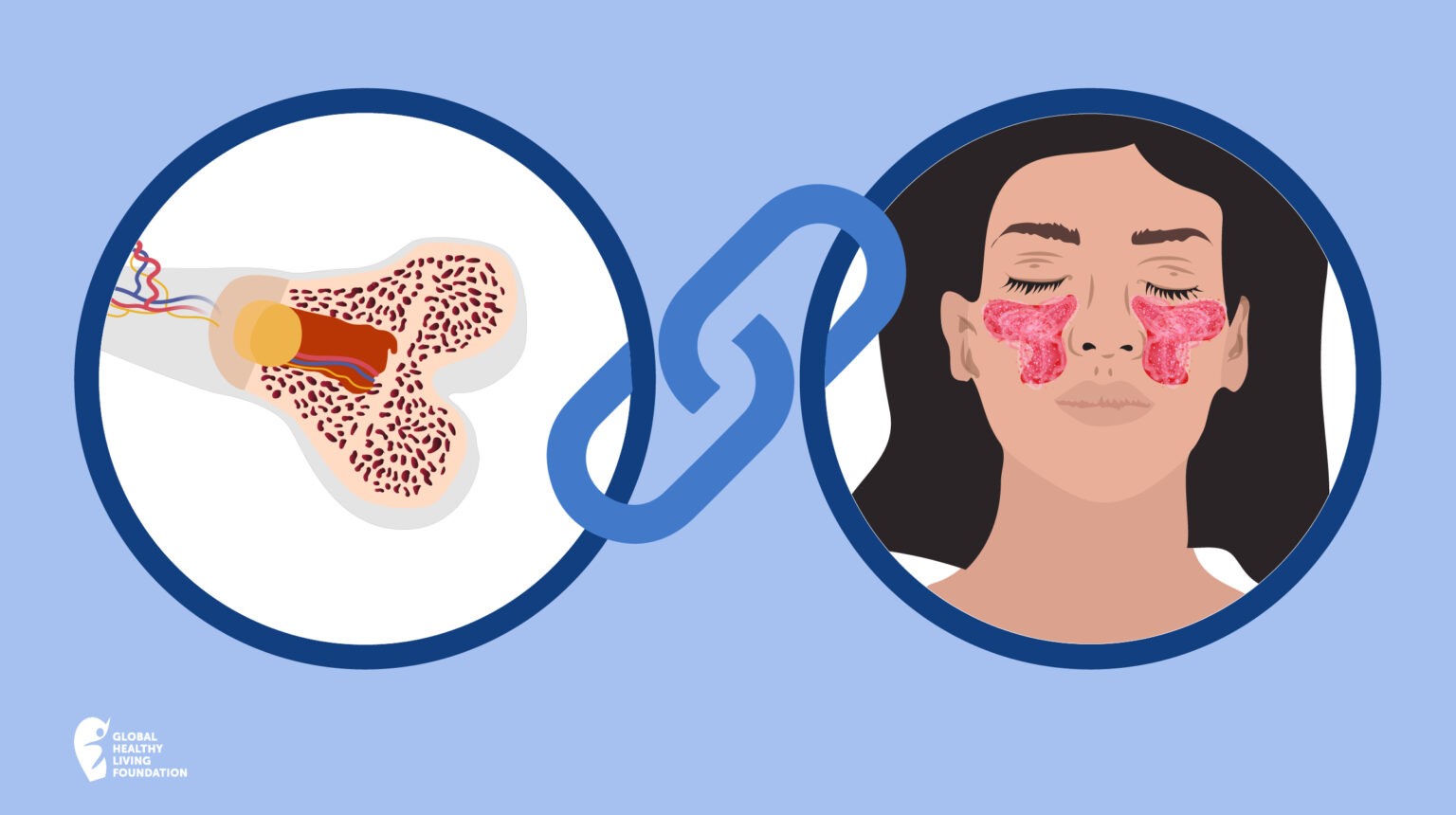

If you Google “lupus symptoms,” it can be easy to fall down a rabbit hole. After all, this condition is notoriously difficult to diagnose and may include many symptoms that overlap with other autoimmune diseases. Lupus signs and symptoms can range from fatigue and fever to weight loss and achy joints.
To make matters trickier, there are four main types of lupus:
- Systemic lupus erythematosus (SLE) — the most common type of lupus
- Cutaneous lupus erythematosus (CLE) — lupus that only affects the skin
- Neonatal lupus
- Drug-induced lupus
However, there are a few key clues that may point your doctor toward a lupus diagnosis. Being aware of these lupus indicators is important as you work with your provider to determine what’s causing your symptoms and advocate for a correct diagnosis.
Here’s what you need to know about lupus symptoms that may overlap with other conditions, plus the symptoms that can distinguish it from other diseases.
Lupus Symptoms That Are Similar to Other Autoimmune Diseases
First, let’s start with the symptoms that make lupus so difficult to diagnose — those that are present in several other diseases as well, including other autoimmune diseases.
“Constitutional symptoms (those that impact the entire body) can be present in many other autoimmune diseases, as they are symptoms from chronic inflammation caused by a systemic autoimmune disease,” says Kichul Ko, MD, rheumatologist and Associate Professor of Medicine at The University of Chicago Medicine.
Here are just a few examples of lupus symptoms that may overlap with other diseases:
- Joint involvement can resemble rheumatoid arthritis, since both lupus and rheumatoid arthritis may lead to symmetrical swelling, pain and redness in the fingers and wrists.
- Dry eyes and mouth, which is a hallmark of the autoimmune disease Sjogren’s syndrome, can also occur in lupus patients.
- Kidney disease is a lupus comorbidity that can lead to decreased kidney function and increased protein spill in the urine. This can resemble systemic vasculitis, an autoimmune disease involving the inflammation of blood vessels.
- Some lupus skin rashes look identical to a rash from dermatomyositis, an inflammatory disease. Experts aren’t sure what causes dermatomyositis, so it’s not classified as an autoimmune disease, however, it’s similar to lupus and other autoimmune conditions.
- Pleurisy, the inflammation of the lung lining, is a lupus symptom that can also occur in other autoimmune diseases like rheumatoid arthritis and Sjogren’s syndrome.
Symptoms That Distinguish Lupus from Other Autoimmune Diseases
One important lupus fact: There is no single indicator of this disease. Your doctor may look at your medical history, do a physical exam and draw lab work if you present with new and unexplained symptoms such as joint pain, rashes and fatigue that could be considered lupus symptoms.
You might be referred to see a rheumatologist if lab results show signs of anaemia, low platelets, low white cell counts, a decline in kidney function or abnormal autoimmune tests, which can all be present in lupus.
Your provider will also consider the specific combination of symptoms you’re experiencing.
“Lupus is less likely to cause erosions in the joints than rheumatoid arthritis, and the joint pain can present with less swelling than as seen in rheumatoid arthritis,” says Zeba Faroqui, MD, rheumatologist at PRINE Health and Founder and CEO of Dr Zeba Consulting. “In contrast, lupus presents more commonly with skin rashes than rheumatoid arthritis does.”
If you have lupus, you may also have a wider variety of symptoms than if you were dealing with a condition like rheumatoid arthritis. In addition to, say, joint pain, you may also encounter the following:
- Change in urine
- Chest pain
- Fatigue
- Frequent bleeding or bruising
- Neuropathy-like symptoms (those involving the nerves, like tingling or pins-and-needles sensations)
- Oral or nasal ulcers
- Shortness of breath
“The presentation of lupus symptoms is far more varied than other autoimmune diseases such as rheumatoid or psoriatic arthritis, which each typically present with their own classic pattern of joint pain, stiffness and swelling,” says Dr Faroqui.
The most distinctive sign of lupus is a butterfly rash that resembles the wings of a butterfly and spans across the cheeks. This rash can be raised or flat and is seen in about 46 to 65 per cent of lupus patients, according to a 2019 article in QJM: An International Journal of Medicine.
However, this is not the only type of rash that may occur in lupus.
“The presentation of lupus rashes can vary dramatically, so it is best to consult with a rheumatologist or dermatologist for further evaluation,” says Dr Faroqui. “Many rashes may present upon reaction to sunlight exposure, which is known as photosensitivity. In approximately 20 per cent of lupus patients, skin rash is their first symptom.”
How Your Doctor Will Diagnose Lupus
There isn’t a specific blood test for lupus, but this type of lab work is still important as your doctor considers what might be causing your symptoms.
“ANA, or anti-nuclear antibodies, can be a helpful test,” says Dr Ko. “If it comes back negative, then the chances are the patient does not have lupus, although negative ANA lupus can also occur on rare occasions.”
Positive testing for certain types of lab work like ANA tests, which many commonly think of as “the lupus test,” is high. Between 12 to 16 per cent of the US population may test positive for the ANA test.
“Many of these ANA tests are negative on repeat testing, or the patients do not have the clinical symptoms that would indicate lupus,” says Dr Faroqui. “Rheumatologists must make the diagnosis taking the patient’s history and clinical examination into account.”
For instance, if you have positive autoimmune tests but do not have correlating symptoms, you might not necessarily have an autoimmune disease like lupus. In that case, your doctor may believe your case warrants further testing or monitoring going forward.
After examining you, looking at your history and reviewing your lab tests, your doctor will look at your whole picture of health to determine if your symptom pattern fits one diagnosis over others. Once they have a hypothesis, your provider will order additional tests to support their theory.
“Let’s say the patient has positive anti-dsDNA antibodies, which are more specific for lupus, and negative rheumatoid factors and anti-CCP antibodies, both of which are for rheumatoid arthritis,” says Dr Ko. “Their X-rays do not show evidence of rheumatoid arthritis, which can cause chronic damage in the joints. In this case, the patient would more likely be diagnosed with lupus.”
One final piece of advice from experts: Make sure you’re working with a rheumatologist who has experience in this diagnostic process — and seek a second opinion when needed. “In order to diagnose lupus, it is important to see a rheumatologist who is trained in distinguishing between different autoimmune diseases,” says Dr Faroqui.
This information should never replace the information and advice from your treating doctors. It is meant to inform the discussion that you have with healthcare professionals, as well as others who play a role in your care and well-being.
This article has been adapted, with permission, from a corresponding article by Kelsey Kloss on the CreakyJoints US website. Some content may have been changed to suit our Australian audience.
Join the CreakyJoints Australia Community
Becoming a CreakyJoints Australia member takes just a few minutes. You’ll receive our members’ e-newsletter featuring:
- Reliable information about arthritis types and treatments.
- Tips for managing daily life with arthritis and related conditions.
- Personal stories from people living with similar conditions to you.
- Links to our podcasts featuring interviews with health clinicians and patients.
- Surveys to help us discover what’s important to you.
Follow us on Facebook
We set up our CreakyJoints Australia Community group on Facebook to share our latest news, feature articles, arthritis resources and other content with you. We invite you to provide feedback on any of our posts and chat with each other in the comments. You are also welcome to share ideas about content you would like us to create or share practical tips for living with arthritis and related conditions.
Keep Reading
CreakyJoints Australia has a wealth of information about arthritis and great tips for dealing with it.
- Classifications of Arthritis
- Choosing Your Healthcare Team
- Expansion of Free Access to the Shingles Vaccine: You Could Be Eligible
- How to manage common respiratory infections: Information for rheumatic disease patients
- Government Support for People With Chronic Conditions
Interview by Kelsey Kloss with Kichul Ko, MD, rheumatologist and associate professor of medicine at The University of Chicago Medicine
Interview with Zeba Faroqui, MD, rheumatologist at PRINE Health and Founder and CEO of Dr Zeba Consulting
Cleveland Clinic: Dermatomyositis. https://my.clevelandclinic.org/health/diseases/15701-dermatomyositis.
Mayo Clinic: Lupus https://www.mayoclinic.org/diseases-conditions/lupus/symptoms-causes/syc-20365789.
Kumar RR, et al. Butterfly rash: hallmark of lupus. QJM: An International Journal of Medicine. April 26, 2019. https://doi.org/10.1093/qjmed/hcz091.
Satoh M, et al. Prevalence and Sociodemographic Correlates of Antinuclear Antibodies in the United States. July 2012. Arthritis and Rheumatism. https://doi.org/10.1002/art.34380.



